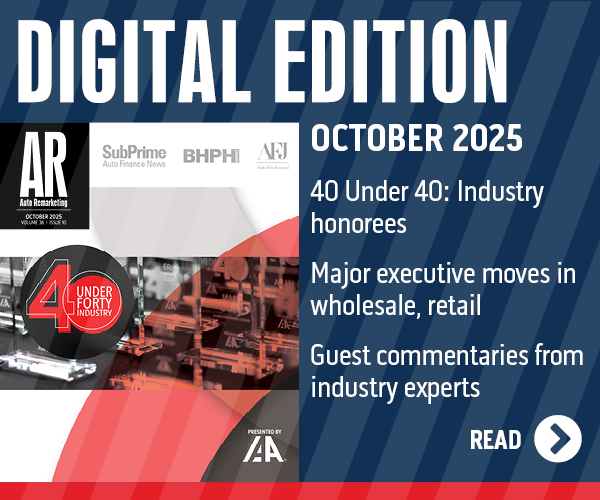February used-car sales to rise, as new-car grosses stay robust

By subscribing, you agree to receive communications from Auto Remarketing and our partners in accordance with our Privacy Policy. We may share your information with select partners and sponsors who may contact you about their products and services. You may unsubscribe at any time.
Used-vehicle market resiliency is likely to be on display again this month, as one projection has February retail sales improving from the opening month of 2022.
Meanwhile, if franchised stores actually have new models to retail, they’re generating grosses that sometimes only their used departments can.
TrueCar said on Friday that used-vehicle sales this month are expected to reach 3.2 million, which would be down 9% from a year ago but 8% higher versus January.
TrueCar also predicted that the average ARP on used vehicles financed in February would be 7.4% with average contract terms stretching out to 70 months.
When in comes to new models, excluding fleet sales, TrueCar is expecting U.S. retail deliveries of new cars and light trucks to be 935,604 units, which would be down 12% from a year ago and up 4% from January.
“After a volatile 2021 in terms of pricing and supply, this month we’re seeing signs of stability,” TrueCar lead industry analyst Nick Woolard said in a news release. “From a supply standpoint, we’re seeing industry new listings roughly in line with January.
Subscribe to Auto Remarketing to stay informed and stay ahead.
By subscribing, you agree to receive communications from Auto Remarketing and our partners in accordance with our Privacy Policy. We may share your information with select partners and sponsors who may contact you about their products and services. You may unsubscribe at any time.
Additionally, from a pricing standpoint, things appear to be settling into a new equilibrium with the smallest month-over-month average price change in at least a year,” Woolard continued.
TrueCar senior vice president of OEM solutions Valeri Tompkins elaborated about the financing component of the new-vehicle market.
“This month we are seeing the lowest levels of leasing since the onset of the pandemic when there was a proliferation of extended term loans,” Tompkins said in the news release. “Historically, leasing has been the go-to option for shoppers looking for the lowest payment but over the past year we have seen that shift.
“For shoppers configuring vehicles on TrueCar, we’re now seeing lower average payments for 72-month loans than 36-month leases.”
Continuing the theme, a joint forecast from J.D. Power and LMC Automotive indicated new-vehicle retail sales for February are expected to decline when compared with February of last year.
The firms said retail sales of new vehicles this month are expected to reach 922,100 units, a 5.7% decrease compared with February 2021.
Thomas King is president of the data and analytics division at J.D. Power.
“With retail inventory on pace to finish a fourth consecutive month below 900,000 units and ninth consecutive month below one million units, the new-vehicle supply situation is not displaying signs of near-term improvement. Therefore, sales in February are being determined by the number of vehicles delivered to dealerships rather than reflecting actual consumer demand,” King said in another news release.
When franchised dealers have those new units to retail, King shared why they might be sharing high-fives when those models roll over the curb.
“Dealers also continue to benefit from high transaction prices with total retailer profit per unit — inclusive of grosses and finance and insurance income — being on pace to reach $5,023, an increase of $2,837 from a year ago and the fifth consecutive month above $5,000,” King said.
“The gains in per-unit profit are offsetting the drop in sales volume as the total aggregate retailer profit from new-vehicle sales is projected to be up 117% from February 2021, reaching $4.6 billion,” he continued.
King also provided more J.D. Power data that reflected the distinct connection the new- and used-vehicle markets have.
“Record new-vehicle prices are being supported by exceptionally strong used-vehicle prices, as new-vehicle buyers benefit from more equity on their trade-in vehicles,” King said. “The average trade-in equity for February is trending towards $9,663, a 93.0% increase of $4,657 from a year ago.”
Over at Cox Automotive, analysts there said new-vehicle sales in February are expected to reach 1.08 million units, a drop of 11% compared to February of last year.
Cox Automotive senior economist Charlie Chesbrough recapped in another news release that new-vehicle sales volume has been averaging just above 1.05 million each month since last August, and February is not expected to buck the trend since inventory levels are not showing significant improvement.
Chesbrough pointed out that new-vehicle inventory is now 62% below last year, and vAuto Available Inventory data showed that available supply declined last week after rising for many weeks.
“The market is heading into a very interesting period,” Chesbrough said in the news release. “With low supply and low sales volume, and no tangible market change expected, a big decrease in the sales pace — a sizable drop in the SAAR — is likely in the offing for next month.
“In the winter, when low sales volumes are expected, seasonal adjustments can result in a relatively strong SAAR, as we have in January and February. But come spring, when sales are expected to be much higher, the SAAR will look particularly weak. Without a big jump in inventory, March’s SAAR is going to show a significant decline,” he went on to say.
King had a similar line of thinking about what could happen in March.
“What we’re seeing in February — sales being constrained by available inventory — is expected to continue in March,” King said. “The underlying question is which manufacturers will have the ability to produce enough vehicles to increase inventory levels. Ongoing supply chain disruptions, along with near-term announcements of production outages by several manufacturers, mean that the aggregate inventory situation is unlikely to change in March.
“For some manufacturers, the situation may deteriorate. This likely means that prices and per-unit profitability for retailers and manufacturers will likely remain healthy,” he added.


